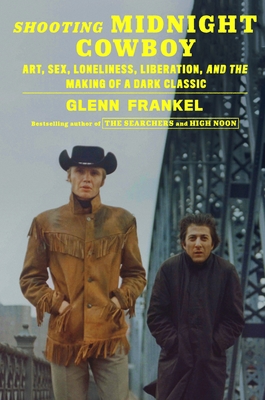Shooting Midnight Cowboy: Art, Sex, Loneliness, Liberation, and the Making of a Dark Classic

Shooting Midnight Cowboy: Art, Sex, Loneliness, Liberation, and the Making of a Dark Classic
Much more than a page-turner. It's the first essential work of cultural history of the new decade. --Charles Kaiser, The Guardian
The Pulitzer Prize-winning journalist and New York Times-bestselling author of the behind-the-scenes explorations of the classic American Westerns High Noon and The Searchers now reveals the history of the controversial 1969 Oscar-winning film that signaled a dramatic shift in American popular culture. Director John Schlesinger's Darling was nominated for five Academy Awards, and introduced the world to the transcendently talented Julie Christie. Suddenly the toast of Hollywood, Schlesinger used his newfound clout to film an expensive, Panavision adaptation of Far from the Madding Crowd. Expectations were huge, making the movie's complete critical and commercial failure even more devastating, and Schlesinger suddenly found himself persona non grata in the Hollywood circles he had hoped to conquer. Given his recent travails, Schlesinger's next project seemed doubly daring, bordering on foolish. James Leo Herlihy's novel Midnight Cowboy, about a Texas hustler trying to survive on the mean streets of 1960's New York, was dark and transgressive. Perhaps something about the book's unsparing portrait of cultural alienation resonated with him. His decision to film it began one of the unlikelier convergences in cinematic history, centered around a city that seemed, at first glance, as unwelcoming as Herlihy's novel itself. Glenn Frankel's Shooting Midnight Cowboy tells the story of a modern classic that, by all accounts, should never have become one in the first place. The film's boundary-pushing subject matter--homosexuality, prostitution, sexual assault--earned it an X rating when it first appeared in cinemas in 1969. For Midnight Cowboy, Schlesinger--who had never made a film in the United States--enlisted Jerome Hellman, a producer coming off his own recent flop and smarting from a failed marriage, and Waldo Salt, a formerly blacklisted screenwriter with a tortured past. The decision to shoot on location in New York, at a time when the city was approaching its gritty nadir, backfired when a sanitation strike filled Manhattan with garbage fires and fears of dysentery. Much more than a history of Schlesinger's film, Shooting Midnight Cowboy is an arresting glimpse into the world from which it emerged: a troubled city that nurtured the talents and ambitions of the pioneering Polish cinematographer Adam Holender and legendary
PRP: 217.00 Lei
Acesta este Pretul Recomandat de Producator. Pretul de vanzare al produsului este afisat mai jos.
195.30Lei
195.30Lei
217.00 LeiLivrare in 2-4 saptamani
Descrierea produsului
Much more than a page-turner. It's the first essential work of cultural history of the new decade. --Charles Kaiser, The Guardian
The Pulitzer Prize-winning journalist and New York Times-bestselling author of the behind-the-scenes explorations of the classic American Westerns High Noon and The Searchers now reveals the history of the controversial 1969 Oscar-winning film that signaled a dramatic shift in American popular culture. Director John Schlesinger's Darling was nominated for five Academy Awards, and introduced the world to the transcendently talented Julie Christie. Suddenly the toast of Hollywood, Schlesinger used his newfound clout to film an expensive, Panavision adaptation of Far from the Madding Crowd. Expectations were huge, making the movie's complete critical and commercial failure even more devastating, and Schlesinger suddenly found himself persona non grata in the Hollywood circles he had hoped to conquer. Given his recent travails, Schlesinger's next project seemed doubly daring, bordering on foolish. James Leo Herlihy's novel Midnight Cowboy, about a Texas hustler trying to survive on the mean streets of 1960's New York, was dark and transgressive. Perhaps something about the book's unsparing portrait of cultural alienation resonated with him. His decision to film it began one of the unlikelier convergences in cinematic history, centered around a city that seemed, at first glance, as unwelcoming as Herlihy's novel itself. Glenn Frankel's Shooting Midnight Cowboy tells the story of a modern classic that, by all accounts, should never have become one in the first place. The film's boundary-pushing subject matter--homosexuality, prostitution, sexual assault--earned it an X rating when it first appeared in cinemas in 1969. For Midnight Cowboy, Schlesinger--who had never made a film in the United States--enlisted Jerome Hellman, a producer coming off his own recent flop and smarting from a failed marriage, and Waldo Salt, a formerly blacklisted screenwriter with a tortured past. The decision to shoot on location in New York, at a time when the city was approaching its gritty nadir, backfired when a sanitation strike filled Manhattan with garbage fires and fears of dysentery. Much more than a history of Schlesinger's film, Shooting Midnight Cowboy is an arresting glimpse into the world from which it emerged: a troubled city that nurtured the talents and ambitions of the pioneering Polish cinematographer Adam Holender and legendary
Detaliile produsului









